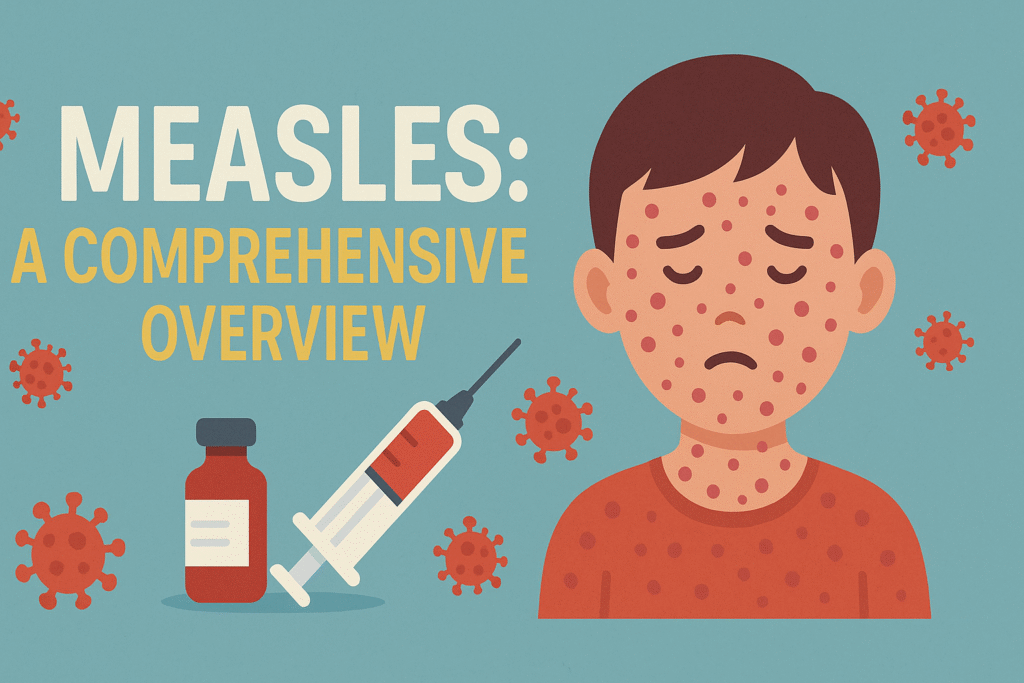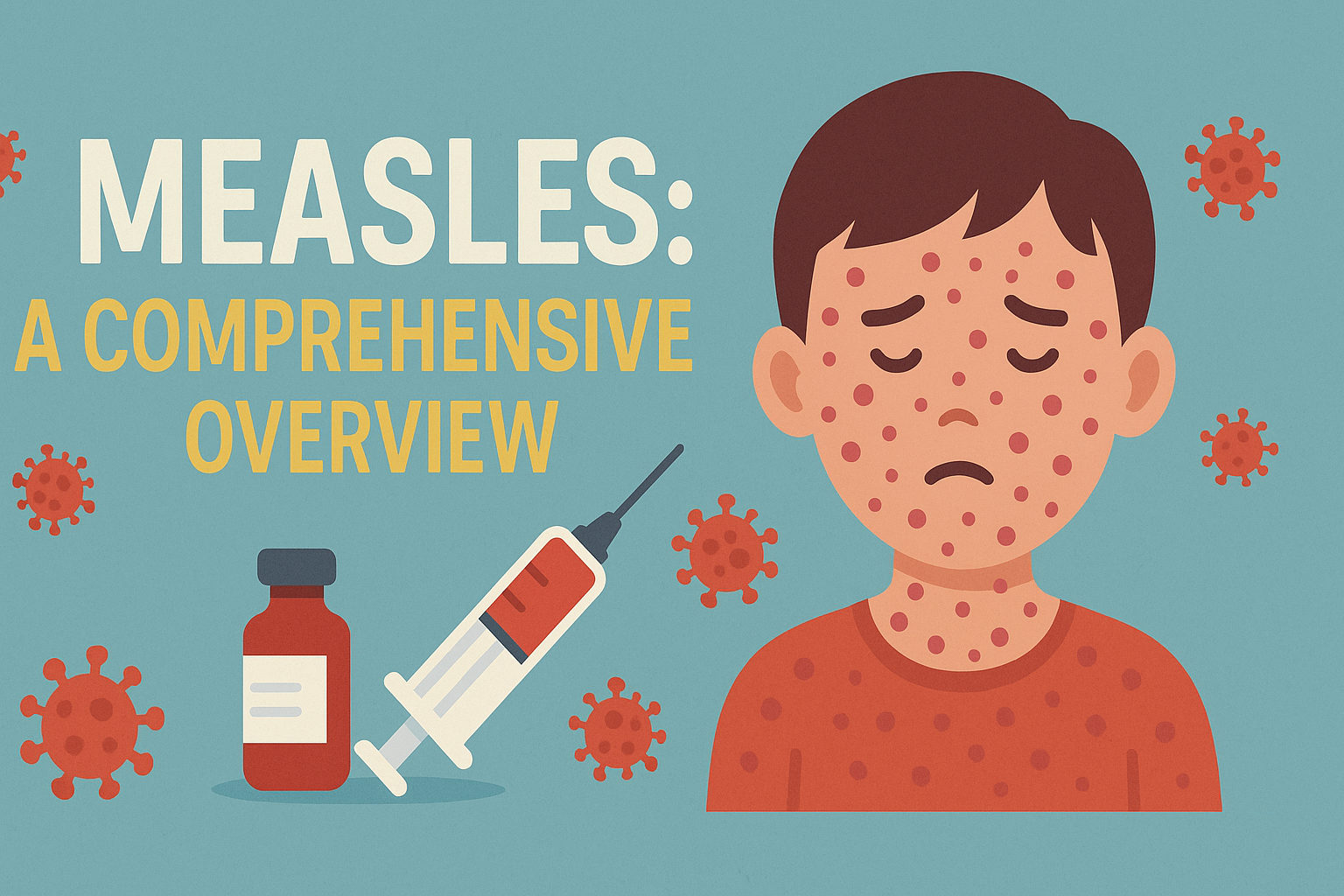Measles, also known as rubeola, is a highly contagious viral disease that remains a significant global health concern despite the availability of an effective vaccine.
Caused by the measles virus, a single-stranded RNA virus in the Paramyxoviridae family, it spreads through respiratory droplets and can lead to serious complications, particularly in unvaccinated populations.
This article explores the causes, symptoms, transmission, prevention, and global impact of measles, emphasizing the importance of vaccination and public health measures.

Causes and Transmission
Measles is caused by the measles virus, which is transmitted primarily through respiratory droplets from coughing or sneezing. The virus can remain infectious in the air or on surfaces for up to two hours, making it one of the most contagious diseases known.
An infected person can spread the virus from four days before to four days after the appearance of the characteristic rash. The virus enters the body through the respiratory tract or conjunctiva, rapidly replicating and spreading to lymphoid tissues, skin, and other organs.
Individuals most at risk include unvaccinated children, pregnant women, and those with compromised immune systems. Measles thrives in communities with low vaccination rates, where herd immunity—typically requiring 90-95% vaccination coverage—is insufficient to prevent outbreaks.
Symptoms
Measles symptoms typically appear 10-14 days after exposure. The disease progresses in stages:
- Prodromal Phase: Initial symptoms include high fever (often exceeding 104°F), cough, runny nose, and red, watery eyes (conjunctivitis). These symptoms resemble a common cold but are often more severe.
- Koplik Spots: Small white spots with bluish centers appear inside the mouth, usually 2-3 days after initial symptoms. These are a hallmark of measles and aid in diagnosis.
- Rash: A red, blotchy rash emerges 3-5 days after the first symptoms, starting on the face and spreading downward to the trunk and limbs. The rash lasts about a week before fading.
Complications can arise, especially in vulnerable groups. These include ear infections, pneumonia, diarrhea, and, in rare cases, encephalitis (brain inflammation). Subacute sclerosing panencephalitis (SSPE), a rare but fatal neurological condition, can develop years after infection, particularly in those infected at a young age.
Diagnosis
Diagnosis is primarily clinical, based on symptoms like fever, rash, and Koplik spots. Laboratory confirmation may involve:
- Serologic Testing: Detection of measles-specific IgM antibodies in blood.
- PCR Testing: Identification of measles virus RNA in respiratory secretions or urine.
- Viral Culture: Isolation of the virus, though less commonly used due to time constraints.
Prompt diagnosis is critical for initiating control measures, such as isolating infected individuals and notifying public health authorities.
Prevention
The measles vaccine, typically administered as part of the measles-mumps-rubella (MMR) vaccine, is highly effective, providing lifelong immunity in most cases. The World Health Organization (WHO) recommends two doses: the first at 9-12 months and the second at 15-18 months.
Vaccination has drastically reduced measles incidence since its introduction in the 1960s, preventing millions of deaths annually.
Herd immunity is essential to protect those who cannot be vaccinated, such as infants under six months or immunocompromised individuals. Other preventive measures include:
- Isolation: Infected individuals should avoid contact with others during the infectious period.
- Hygiene: Handwashing and covering the mouth during coughing or sneezing reduce transmission.
- Post-Exposure Prophylaxis: Administering the measles vaccine within 72 hours or immunoglobulin within six days of exposure can prevent or lessen disease severity.
Treatment
There is no specific antiviral treatment for measles. Management focuses on supportive care:
- Fever Reduction: Acetaminophen or ibuprofen to manage fever and discomfort.
- Hydration and Nutrition: Ensuring adequate fluid intake and addressing malnutrition, which worsens outcomes.
- Vitamin A: Supplementation can reduce complications, particularly in children with deficiencies, as it supports immune function and epithelial health.
- Antibiotics: Used only for secondary bacterial infections like pneumonia or ear infections.
Severe cases may require hospitalization to manage complications such as respiratory distress or dehydration.
Global Impact
Measles remains a global health challenge, particularly in low-resource settings. In 2019, the WHO estimated 207,500 measles deaths worldwide, mostly among children under five. Outbreaks often occur in areas with low vaccination coverage due to vaccine hesitancy, conflict, or limited healthcare access.
For example, a 2019 outbreak in the Democratic Republic of Congo resulted in over 6,000 deaths, highlighting the consequences of vaccine inequity.
The WHO’s Measles and Rubella Elimination Strategy aims to eliminate measles in at least five WHO regions by 2030. Progress has been made—global measles deaths dropped by 73% between 2000 and 2018—but setbacks occur due to vaccine misinformation and disruptions like the COVID-19 pandemic, which delayed routine immunizations.
Challenges and Future Directions
Vaccine hesitancy, fueled by misinformation about MMR vaccine safety, remains a significant barrier. Despite extensive evidence confirming the vaccine’s safety, myths about autism or other adverse effects persist, leading to outbreaks in high-income countries, such as the 2019 U.S. outbreaks affecting over 1,200 people.
Equitable vaccine distribution is another challenge. Low-income countries face logistical barriers, including cold chain storage issues and healthcare worker shortages.
Strengthening health systems, improving vaccine access, and countering misinformation are critical to achieving global elimination.
Conclusion
Measles is a preventable yet potentially deadly disease that underscores the importance of vaccination and robust public health systems. While significant progress has been made, ongoing efforts to combat vaccine hesitancy, improve access, and maintain high immunization rates are essential.
By prioritizing these measures, the global community can move closer to eliminating measles and protecting vulnerable populations from its devastating effects.
